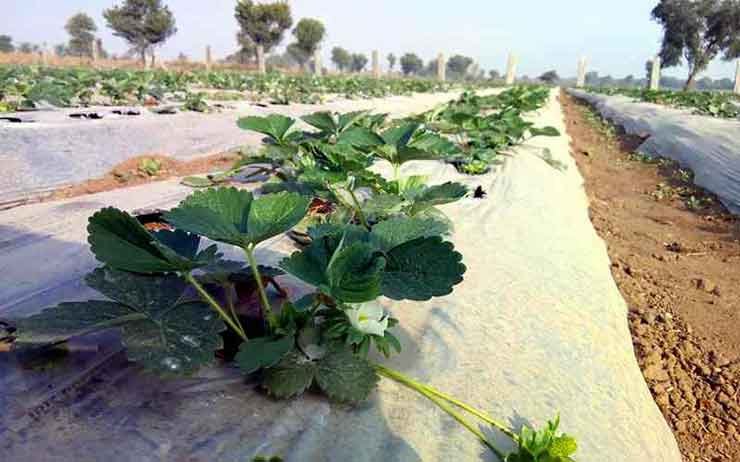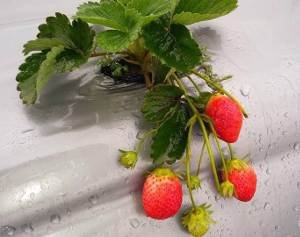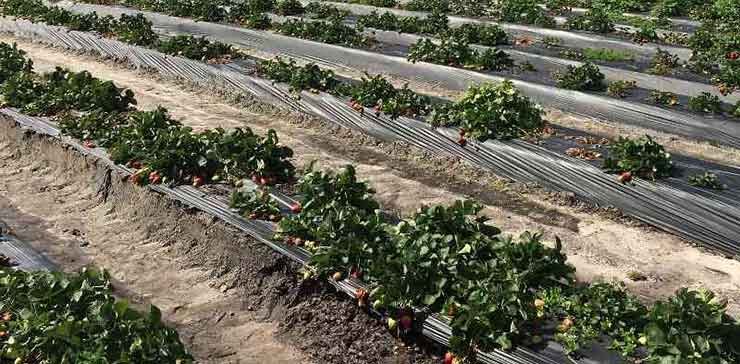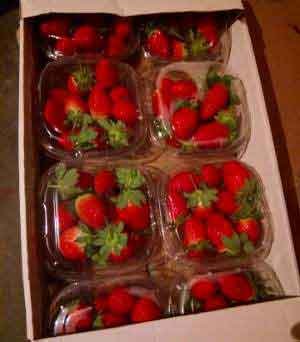Strawberry cultivation is a very profitable agribusiness if it marketed well. Strawberry is a very perishable fruit and that’s why farmers should take utmost care of their strawberry plants. Here is the complete information on strawberry farming in India, plantation, plant protection and marketing.
Strawberries are very popular as ice-creams, cakes, milkshakes and other such desserts worldwide. The fruit is very popular owing to its nutritional quality, color, aroma, texture and of course, its taste. Artificial flavoring is also used in cosmetics, hand sanitizers, candies, etc. United States is the world’s largest strawberry producer followed by Turkey, Spain, Egypt, Mexico and Poland. In India, strawberries are cultivated in Satara districts, Kalimpong in West Bengal, Bangalore, Nainital and Dehradun. Among these, Satara districts of Mahabaleshwar, Wai and Panchgani account for total 85% of strawberry cultivation in India.
Information on Strawberry Plant

The botanical name of strawberry is Fragaria ananassa. It is a herbaceous plant with a fibrous root system. The flowers appear in small clusters and are generally white in color. Very rarely they appear reddish. The strawberry fruit is not a ‘berry’ in the true sense. The fleshy part of the fruit is actually a holder (receptacle) for holding the ovaries together. The part appearing as seeds are actually ovaries enclosing the seeds and they appear on the outer side of the fruit.
Ideal Conditions for Strawberry Cultivation
Climate for Strawberry Plantation
Strawberry needs a temperate climate for cultivation although some of the varieties can grow in subtropical climate. They are short day plants. During flower formation, they need a photoperiod (sunlight) of eight to twelve hours for about ten days. They are dormant and do not grow during winters. Winter is followed by spring when the days grow longer. Therefore, the plants get sunlight initiating flower development. However, in case of varieties grown in sub-tropical regions wherein winters are mild the plants continue to grow. Strawberries are classified into two groups on the basis of their response to the length of photoperiod as:
- Overbearing Varieties– They develop flower buds during long as well as short light periods.
- Commercial Varieties– They flower only during the short light periods.
Soil for Strawberry Cultivation
Strawberry has a fibrous root system. Hence majority of its roots remain in the top soil penetrating maximum to a depth of 15 cm. Hence, it requires a humus-rich soil for cultivation. It should be taken care that strawberry is not grown on soil that was previously used for tomato, potato, raspberry, pepper or eggplant cultivation since these are highly nutrient extracting plants. They drain the soil of their nutrients.
pH
Strawberry grows best in slightly acidic soil with a pH of 5.0-6.5. It can also grow in soil with pH between 4.5 and 5.5 with liming.
Season of Strawberry Plantation
Maximum vegetative growth of strawberries takes place during autumn. It becomes dormant when winter sets in. Post winter, it starts flowering during spring. Hence, strawberries are normally planted during September to October months. An early plantation would result in lower yield since such plants lack vigor.
Water Requirement and Irrigation
Being a shallow-rooted plant strawberry requires frequent watering else it would get affected by drought conditions. However, it does not need much water in terms of quantity. Water is required to just keep the roots moist so as to promote vegetative growth.
Autumn plantation boosts vegetative growth if the runners are irrigated regularly after planting. In addition, frequent irrigation of newly planted buds ensures increase in the runners being produced thus resulting in early rooting. During the time of plantation, if there is no rain then the field is irrigated twice a week. The frequency reduced to once a week in November. During the winter months of December and January, the irrigation is done once in every fifteen days. The frequency is increased again when the flowers start developing into strawberry fruits. A frequent irrigation during the fruiting stage helps give larger fruits.
The soil moisture at any point of strawberry cultivation must be maintained at less than 1.0 atmosphere. Excess irrigation is harmful for the plant. The rows and alleys are irrigated 2-3 days before cultivation. During irrigation care must be taken to dispense water at the root. Wetting the flowers leaves or fruits may increase the chances of fungal infection. Judicious irrigation is necessary during the harvesting period so as to obtain good quality fruits.
Other Environmental Conditions
Strawberry is a slightly sensitive plant and is affected easily by changes in environmental parameters like light intensity, temperature and photoperiod. Winter injury and frosts can affect the yield of the fruit. Similarly, changes in the photoperiod affect the plant morphology, vegetative growth and thus the yield.
Planting Material for Strawberry Plantation

Strawberries are propagated through runners via the vegetative method. They are mulched using materials like straw and polythene. Mulching in black colored polythene helps in controlling the weeds. Mulching is practiced so that freeze injury and chances of fruits softening are reduced.
Strawberry Varieties
Different varieties of strawberries are available that are pest and disease resistant. They can be adapted to different climatic conditions much easily, have a higher yielding capacity and good runner producing capacity.
Chandler
- Large-sized fruits with firm skin and flesh.
- A single strawberry weighs around 18 grams.
- Owing to the outstanding color and flavor, the berries are popular for desserts.
- They are tolerant towards viral attacks and resistant to physical damages caused by rain.
Tioga
- Large-sized fruits with firm skin and flesh.
- A single berry weighs 9 grams approximately.
- An early maturing variety.
- They are tolerant to viral attacks.
Torrey
- Large-sized fruits with skin and flesh of medium firmness.
- They produce numerous runners.
- Each berry weighs about 6 grams.
- The dessert quality is excellent and so is the processing quality.
- Tolerant towards viral attacks.
Selva
- Being day-neutral variety, it produces off-season fruits.
- Large-sized, conical to block-shaped fruits with a firm flesh and skin.
- Individual berry weighs upto 18 grams.
- Has excellent dessert quality.
- They can be shipped and handled during transportation.
Belrubi
- Large, conical fruits with bright red skin and flesh.
- Tastes sweetly acidic.
- Individual berry weight is around 15 grams.
- Plants produce runners.
Fern
- This variety is early ripening and day neutral.
- It is of overbearing type cultivar.
- Fruit-size varies from medium to large with firm, red-colored skin and flesh.
- Produce excellent flavour.
- Well-suited for the fresh market.
- Fruit taste varies between sweet to slightly acidic.
- Individual berry weighs between 20-25 grams.
Pajaro
- Large-sized fruits with red-colored, firm skin and flesh.
- They are susceptible to damage caused by rain but are tolerant to viral attacks.
Some of the other strawberry varieties grown commercially are Red Coat, Premier, Bangalore, Dilpasand, Florida 90, Local, Jeolikot, Pusa Early Dwarf, Katrain Sweet and Blakemore.
Crop Rotation in Strawberry Cultivation
Strawberry demands a lot of nutrients from soil. Hence it must be rotated with leguminous crops like beans after harvest. Once harvested it is advisable to cultivate strawberry again after a period of one year.
How to Grow Strawberries
Land Preparation for Strawberry Cultivation

For cultivating strawberry, the land must be ploughed deeply and then harrowed. Organic manure like farm yard manure, neem cake, etc. is mixed with the soil before planting the runners. Once the ploughing is complete the land is prepared for planting. Different systems of strawberry plantation are followed such as matted row, hill system, spaced row or plastic mulch.
Matted Row
This is the most common system of plantation followed in India. It is the most economical and easiest method of cultivation. Runners are planted with spacing of 90 x 45 cm. The runners after the initial growth are allowed to cover the vacant space around the mother plant. This gives it a matted appearance. Heavy soils wherein weeds do not grow easily are used for strawberry plantation in this method. It must be taken care to prevent overcrowding in this method.
Hill System
This method of cultivation is followed when only a few runners must be developed. The runners must the mother plants are removed. Hence, the individual plants that grow are large in size and bear more fruits than those in matted rows. The inter-planting distance must be 25-30 cm. The distance between the twin rows must be 100 cm. A twin row system is followed here.
Spaced Row
In case of cultivars producing average to weak runners, the daughter runners are kept at certain distance. Only some tips of runners are chosen which can develop into plants. Such tips are covered with soil. The practice is followed till each mother plant has the desired number of daughter plants.
Plastic Mulch

As the name suggests, a black, plastic film is used as mulch. The main idea is to control the weeds and preserve the moisture content. The plants bloom earlier than otherwise and they are less susceptible to damage by frost.
Sowing Strawberry Plant
At the time of plantation, they must be set in soil softly with the roots running straight downwards. Then the soil must be packed in a compact manner around the roots to keep air out. However, ensure that the growing point of the strawberry plant stays just above the soil surface. They must be irrigated immediately after planting and must not be allowed to dry.
After Planting Care
Flower stems appearing on plants in the initial stages after planting must be plucked. This is so that the plants do not drain causing a reduction in their vitality. This practice also helps the plants adapt themselves to drought and heat better. In case of cultivars that produce lesser number of daughter plants, this practice helps increase the strawberry plant to set in soil and also increase the number of runners. Surplus plants are removed from outside the row during autumn or late summer if matted row system is followed.
It is very important to keep the crops free of weeds especially if it is the first cultivation. Plastic mulch is the most common way of keeping the weeds away. Enough soil must be kept around the crown of the plant without covering it. In addition, the cultivation must be restricted to the upper 2.5-5 cm layer of the soil. This practice is continued till the application of straw mulch.
Diseases and Plant Protection
The most common strawberry diseases are black root rot, red stele, leaf spot and grey mold. Red stele is caused by a fungal species named Phytophthora fragariae. Growing resistant varieties would help control the disease. One way to control black root rot is to rotate strawberry with leguminous crops. It is also important to maintain the vigor of the plants by plucking the flower stems that develop in the initial stages. Also at the time of watering the plants, care must be taken to irrigate the soil near the base of the plant. Water sprinkling on the leaf, fruit or flower surface increases the chance of fungal infection.
Viral diseases affecting strawberry are crinkle, dwarf and yellow edge. The most practice for avoiding these diseases is to grow resistant varieties. In case of hill system of plantation the runners must be raised in nurseries.
Strawberries are also infected by pests like cutworms and red spider mites. Spraying the field with 0.05% monocrotophos and 0.25% wettable Sulphur can control the mites. The soil must be dusted with 5% chlordane before planting to check the spread of cutworms.
Harvesting Strawberries

Strawberry season in Mahabaleshwar, Nainital and Kashmir starts during May to June when strawberries start ripening while it ripens during late February to April months in the plains. It is harvested when the fruits are firm and about three-fourth of the fruit has developed the color. For local markets they are picked when fully ripe. Normally, harvesting is done on a daily basis. If the weather is dry then they must be harvested early in the morning. After harvesting they must be packed directly in flat, shallow containers. Do not wash them as washing causes them to get bruised and lose color.
Alternate Revenue
In order to provide a boost to the tourism industry and also provide the farmers with alternate revenue, many tourist operators have tied up with farmers for strawberry plucking. The tourists can visit the farms, interact with the farmers, learn a few things about strawberry gardening and pluck strawberries to take them home. This form of tour is a hit among tourists since they gain hands-on experience in farming. From the farmers’ point it is an excellent way to earning extra revenue. It also boosts sales for the local markets.
Storage, Packing and Transport

After plucking the strawberries they are graded and packed immediately into shallow trays. The trays maybe made of bamboo, cardboard or paper. Fruits can be stored under cold storage for upto 10 days. If they are to be transported to distant places, then the strawberries are pre-cooled at 4⁰C within 2 hours of harvesting and then shipped in refrigerated vans.
Profit from Strawberry Cultivation
Strawberry cultivation in India is very profitable as supply of strawberry fruit is much less than demand. Strawberry fetches good market rates. One should take a survey before strawberry plantation as rural markets are not favourable for strawberries but it can be marketed in supermarkets as well as small to big towns and cities.
Reference
- http://www.krishisewa.com/articles/production-technology/263-strawberry.html
- http://kiran.nic.in/pdf/technology-bouquet/selected_tecnology_Profile/strawberry.pdf
- https://en.wikipedia.org/wiki/Strawberry
- https://www.britannica.com/plant/strawberry
- https://www.ces.ncsu.edu/depts/pp/notes/oldnotes/fd5.htm
- https://timesofindia.indiatimes.com/city/pune/strawberry-picking-tours/articleshow/56294994.cms

Give information about upgrading price and seasonal price in India.
Dear madam,its a very nice and needful informations provided by you.madam kindly provided me strawberries farmer informations in all over india.
From where to get strawberry saplings
Hello,
I have read through the post and it’s very informative and clearly explained. However, I have a question.
How and from where do we get the initial strawberry saplings?
Any contact details will really help. Thank you!
AJAY SHASTRI
Hello
I am Rahul baghel from Bhopal (Madhya Pradesh) I want to grow strawberry plants .
Can I do it at normal field conditions .
Please reply me
Hello
I’m Shaban from Tanzania I pass through your information and well attracted to cultivate strawberry but the place where I’m I there is hot environment
Is it possible to cultivate?